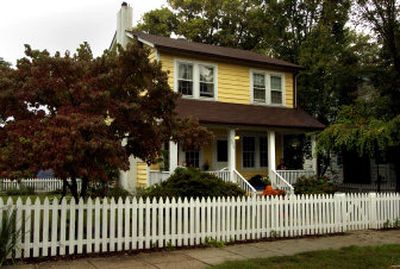Go slow at remodeling

WASHINGTON – In the era of instant messaging, overnight delivery and 5-hour transcontinental flights, it can be difficult to accept that home improvement takes time. But most people don’t move into a house they find perfect in every way, and certainly don’t have the wherewithal to turn it overnight into the house of their dreams.
You would think that the myriad home-improvement shows on TV might try to at least hint at the reality of remodeling. Instead, we see Ty and his blow-dried crew gut and reconstruct a 100-year-old farm house in one week on “Extreme Makeover: Home Edition” while in real life it’s standard to wait six times that long for special-order floorboards. Or we watch an ugly room transformed in 48 hours, when we know it takes that long for painters to return a phone call.
The cold, hard truth is that getting from fixer-upper to fixed-up requires planning, vision and patience. The good news, however, is that home renovation may be one of the few activities left in our fast-forward culture that rewards a slower approach. People who take their sweet time to redo their homes report that it’s easier on their pocketbooks, less disruptive of their lifestyles and – because decisions are made in less haste and under less pressure – more likely to yield satisfying results.
“I grew up in the sort of house where we did all of our own stuff,” says Steve Gately of Washington. “My dad never hired anyone to come and do anything.”
Genetically predisposed toward DIY, Gately is not the type to sacrifice his control over a project on the altar of expediency. Since he and his wife, Lisa Dewey, bought their 1925 Dutch Colonial revival house in 2001, they’ve been turning it into the place they’ve always wanted, spreading the enterprise out over the years so that their renovation plan reads like the paper placemat at a Chinese restaurant.
For Gately and Dewey, 2002 was the Year of the White Picket Fence. “It took two days to put it in and three months to paint it,” Gately says. “I primed it and got a third of the way through with the first coat using a sprayer before giving up” and calling for professional help. (All sons rebel against their fathers at some point.)
Next came the Year of Basement Transformation. In 2003, the unfinished space below the couple’s house was outfitted with a new ceiling, drywall and bathroom; it now serves as a guest room. That year, Gately and his wife had their first baby and decided they just couldn’t spend another blazing D.C. summer relying on air-conditioning units to cool down their 1,140 square feet. That fateful decision ushered in 2004, known forevermore as the glorious Year of Central Air.
So far, 2005 is shaping up to be the Year of Exterior Beautification. Plantings are popping up around the perimeter of the house, just weeks after completion of the front porch: floor planks painted a cheery blue, new railings and a beadboard ceiling the shade of a robin’s egg.
Peering into his crystal ball, Gately has seen the future – and it looks like an open kitchen/dining plan, complete with new cabinets, an island and maybe French doors leading out to a deck. That, he says, should take up a fair chunk of 2006.
Though glacial by many people’s standards, the pace suits Gately just fine. “You get to put your own personal touch on a house when you take your time,” he says. “The best advice we were given when we bought this house was in regard to the landscaping: ‘Give it a full year before you do anything.’ They meant you should give your yard a full year to see what pops up: bulbs, azaleas, hydrangeas, whatever. But I think the advice applies to the whole house. You need to live in a house for a while in order to learn what really needs to be done and what doesn’t.”
Joel Floyd and Karen Sondak moved into their 1926 red-brick bungalow in 2001. Since then, they have been tenderly ministering to its many needs, one project at a time. Four years later, the finish line is almost in sight.
“It had been vacant for years and was pretty run-down,” Floyd recalls.
A different type of buyer would have run screaming from the house. But “we loved all the incredible details, like the built-ins and the original light fixtures,” says Floyd. “So we had it inspected, and the inspector said it had been built really well. We bought it with no contingencies; we didn’t care about the shape it was in so long as it was structurally sound.”
Floyd and Sondak knew they could find some way to live among the ruins. In 2003, a protracted bathroom renovation robbed the couple of a place to bathe for nearly three weeks; Floyd configured a stopgap solution in the dark, labyrinthine basement, “basically just a plastic sheet and a spigot over a drain. That was our shower while the bathroom was being redone.” For three months in 2004, while their kitchen underwent a makeover, the couple ate little else but salads, says Sondak.
Now that their main floor is finished, they are renovating the basement, which should be finished this year, Floyd predicts. The big project for 2006 is the attic.
Floyd, who estimates that they’ve spent $75,000 so far on fixes, says the main advantage of their slow-going approach is one of focus.